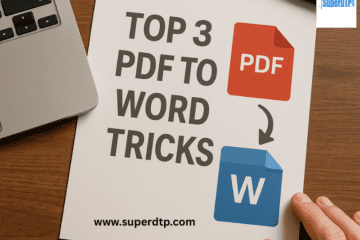Businesses and organizations are expanding into new areas and attracting new audiences as the globe becomes more linked. They frequently have to translate their content into several languages to accomplish this. Even though it seems straightforward, translation can be difficult, particularly when it comes to DTP translation. The process of developing and preparing electronic documents for printing or online publication is known as desktop publishing, or DTP. The difficulties of DTP translation will be discussed in this blog, along with advice on how localization specialists may perfect the technique.
What is Post-Translation DTP?
Post-Translation DTP is the process of translating and localising electronic documents for printing or online publication, such as brochures, flyers, and marketing materials. Along with translating the text, this procedure also include making sure that the document’s layout and design are maintained in the target language. Particularly when working with languages like Chinese or Arabic that employ various scripts or character sets, this can be a difficult and time-consuming task.
Why is Post-Translation DTP important?
Post-Translation DTP is crucial because it enables companies and organisations to broaden their reach and enter new markets. They may engage with new customers, raise brand awareness, and boost sales by translating their material into several languages. The DTP translation must be done precisely and professionally, though, as a poorly translated document can reflect poorly on the organisation and harm its reputation.
Challenges of Post-Translation DTP
Post-Translation DTP presents several challenges, including:
1. Preservation of document layout and design
One of the biggest challenges of translation is preserving the document layout and design in the target language. This can be especially challenging when dealing with languages that use different scripts or character sets, such as Arabic or Chinese.
2. Formatting issues
Another challenge of translation is formatting issues. During the translation process, text may be re-sized, causing the document layout to become distorted. This can be especially problematic when dealing with tables, graphs, or other complex document elements.
3. Managing multiple versions
Translation often involves creating multiple versions of the same document in different languages. This can be time-consuming and complex, especially when dealing with large and complex documents.
4. Localization of images and graphics
Finally, post-translation DTP also involves localizing images and graphics. This can be challenging because images and graphics may need to be modified or re-created in the target language to ensure that they are culturally appropriate and meaningful.
Tips for Mastering Post-Translation DTP
To master the art of post-translation DTP, localization professionals can follow these tips:
1. Use specialized DTP software
Specialized DTP software can make the translation process easier and more efficient. These programs allow you to maintain the document layout and design, while automatically handling the translation of text and graphics.
2. Work with a professional translation agency
Working with a professional translation agency can help ensure that your translation is accurate and professional. A professional agency will have experienced translators who are familiar with the challenges of DTP translation and can help you navigate the process.
3. Plan ahead
To minimize the challenges of post-translation DTP, it’s important to plan ahead. This means determining the target languages and audiences, identifying any cultural differences that may impact the translation, and creating a project timeline and budget.


